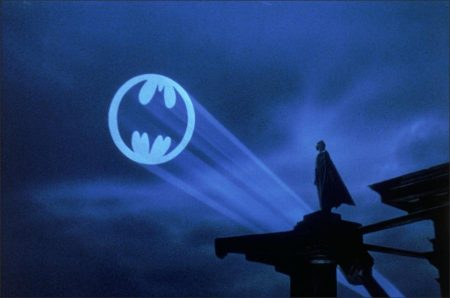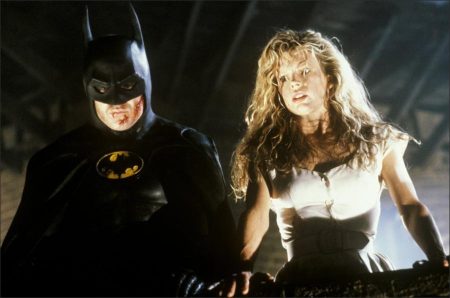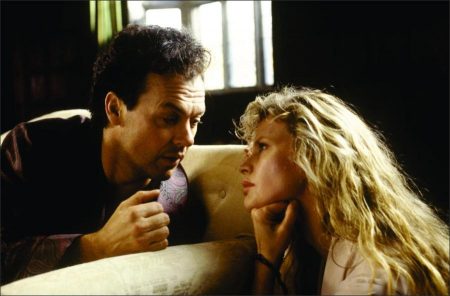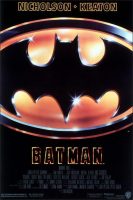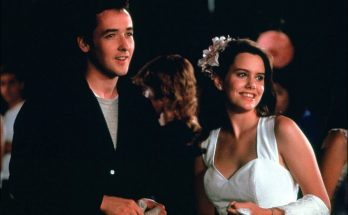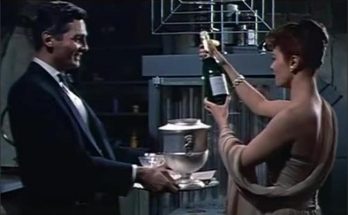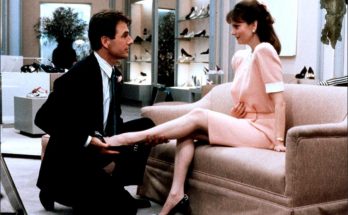Taglines: Only one will claim the night.
Batman movie synopsis. Gotham City. Crime boss Carl Grissom (Jack Palance) effectively runs the town but there’s a new crime fighter in town – Batman (Michael Keaton). Grissom’s right-hand man is Jack Napier (Jack Nicholson), a brutal man who is not entirely sane… After falling out between the two Grissom has Napier set up with the Police and Napier falls to his apparent death in a vat of chemicals. However, he soon reappears as The Joker and starts a reign of terror in Gotham City. Meanwhile, reporter Vicki Vale (Kim Basinger) is in the city to do an article on Batman. She soon starts a relationship with Batman’s everyday persona, billionaire Bruce Wayne.
Batman is a 1989 American superhero film directed by Tim Burton and produced by Jon Peters, based on the DC Comics character of the same name. It is the first installment of Warner Bros.’ initial Batman film series. The film stars Michael Keaton as Bruce Wayne/Batman, alongside Jack Nicholson, Kim Basinger, Robert Wuhl, Pat Hingle, Billy Dee Williams, Michael Gough and Jack Palance. In the film, Batman is widely believed to be an urban legend until he actively goes to war with a rising criminal mastermind known as the Joker.
Film Review for Batman
Dark, haunting and poetic, Tim Burton’s “Batman” is a magnificent living comic book. From its opening shots, as the camera descends into the grim, teeming streets of Gotham City, the movie fixes you in its gravitational pull. It’s an enveloping, walk-in vision. You enter into it as you would a magical forest in a fairy tale, and the deeper you’re drawn into it, the more frighteningly vivid it becomes.
Ultimately, that’s what “Batman” is — a violent urban fairy tale. And it’s as rich and satisfying a movie as you’re likely to see all year. But though it springs from American pulp origins and provides comic book pleasures, it expands upon them as well, transmuting the raw material into operatic gold. Burton’s pop vitality and his ability to make the world over in surreal cartoon terms could have been predicted from “Pee-wee’s Big Adventure” and “Beetlejuice,” but nowhere in those films is there a sign of the muscularity and emotion he shows here.
Photographed by Roger Pratt, the movie is visually symphonic, with layers and layers of detail and color. Gotham City itself is both recognizable and alien, an imaginative extension of contemporary urban chaos. Anton Furst’s sets have a post-Industrial Age grandeur. The buildings are heavy and squat; they’re monumental examples of urban rot.
Clearly, the movie’s Gotham is meant to be a nightmare variation on present-day New York City. (It even has Ed Koch and David Dinkins stand-ins, played by Lee Wallace and Billy Dee Williams.) As its 200th-birthday celebration approaches, it is in the grip of a brutal crime wave, orchestrated by Carl Grissom (Jack Palance), the boss of bosses, and his head henchman, Jack Napier (Jack Nicholson). In his stylish threads, Napier is the most dapper of the crooks, a fact that has not gone unnoticed by Grissom’s moll, Alicia (Jerry Hall), who’s two-timing the capo with his lieutenant.
Batman and the Joker are essentially each other’s creations. The Caped Crusader brings his arch-rival to life by letting Napier slip from his grasp into a vat of toxic chemicals. What emerges from the ooze is a macabre caricature of Jack Napier. Billing himself as “the world’s first fully functioning homicidal artist,” the Joker is an incarnation of all the indiscriminate psychopaths who kill for the sheer, exhilarating fun of it. Defacing old masters and beautiful women with equal panache, the Joker takes riotous pleasure in his evil-doing.
Nicholson, too, seems to be having a blast, and he brings a sense of dangerous hilarity to the character. Dressed in lurid lavender suits with orange silk shirts and aquamarine ties, he plays his green-haired trickster as a prancing, camp maniac. Beneath the Joker’s killer jokes, though, the violence is palpable. Nicholson’s acting here is dexterous, dancerly; physically, he’s a wild-man combination of Barrymore, Baryshnikov and Jackie Gleason. Ogling a picture of the famous photojournalist Vicki Vale (Kim Basinger) — who becomes Wayne’s girlfriend — he hisses, “She could put steam in a man’s strides.” This may be the nuttiest serious performance ever given by a major star. Nothing Nicholson does is expected or mundane — he’s brilliantly bonkers.
But if Nicholson’s maniacal Joker is the movie’s engine, Michael Keaton’s Batman is its cool, forceful center. Burton specializes in freaks, and in this sense the comic book characters that Bob Kane and others created are certainly prime subjects. What he does, simply, is make them and their world real. Miraculously, he does this by heightening the story’s fantastical theatricality. When Batman makes his entrance, unfurling his cape to display its full wingspan, the image carries a charge of supernatural grandeur. In black from ear-tip to toe, this Batman is truly a larger-than-life figure, potent and terrifying, and the flourish with which he’s brought onstage allows him to rise to his full superhero stature.
Under the costume, though, is a man, and Burton never loses sight of that. For Batman purists, Michael Keaton was an upsetting choice, but it’s a choice brilliantly redeemed in realization. What Keaton brings to his characterization of both Batman and his millionaire-playboy alter ego, Bruce Wayne, is a quality of coiled concentration, a wary vigilance. In his Batsuit, Keaton’s movements are stylized, almost robotic, and the stiffness of movement carries Arthurian associations, as if he were indeed a dark knight, armored for battle.
As Batman, Keaton’s plush lips and piercing eyes are as much a part of his uniform as the hood and cape — they emphasize the flesh under the superhero armament. But as evocative as he is in his Bat regalia, it’s as Bruce Wayne that Keaton announces his own arrival. This is a true star performance, subtle, authoritative and sexually vibrant. As Wayne, the actor moves with a brisk and economical gait, and hidden in it is the suggestion of an athlete trying to hold his natural ease of movement in check. Keaton doesn’t play Wayne as a brooding neurotic; he’s more of an eccentric, distracted, socially clumsy and ill at ease with his wealth. Still, there’s genuine pain in the performance, signs of a wounded man trying to shake free of childhood traumas.
The Warren Skaaren-Sam Hamm script portrays Wayne as a realist who isn’t sure himself why he does what he does. Driven by the vision of his parents’ murder, his life is not his own. When Vale challenges Batman’s sanity by saying, “You’re not exactly normal, are you?” He answers, fiercely, “It’s not a normal world.”
In Burton’s hands, it is and it isn’t. The movie has a churning, locomotive energy. It keeps plowing ahead, at times slowing down, but never actually coming to a stop. But though it sustains itself at a remarkably high pitch, there are botched sequences and patches where the action is unintelligible or inelegant. Also, as thrilling as Nicholson’s work is as the Joker, Burton may be overenthralled with the character to the detriment of Keaton’s Wayne. (He may also be compensating for holes in the script.) Supporting the stars, Michael Gough is marvelous as the butler Alfred (he plays him as a kind of yenta), but in some of the minor roles the actors are either unremarkable (Kim Basinger) or intrusive (Robert Wuhl).
Still, the director’s conceptual grasp of his material is remarkably sure. The Danny Elfman score complements the film’s monumental atmosphere. (The Prince songs, on the other hand, break the mood.) Inspired by the classic Batman stories in DC Comics and the revisionist versions of Frank Miller, Alan Moore and others, this Batman tale is very much Burton’s and very much centered in the physical world of gravity and human limitations.
These heroes are our metaphorical selves, colorful externalizations of our psychological conflicts, and therefore, at times, overwhelmingly potent. They’re our pop archetypes, and Burton applies a flamboyant showmanship to bring them to life. The adversaries’ final danse macabre — or, as the Joker calls it, “the big duckeroo” — is an electrifying bit of moviemaking. Your emotions are plugged right into it in a way they seldom are in movies like this. But then again, there haven’t been many movies like this. In some ways, it’s a masterpiece of pulp, the work of a true artist.
Batman (1989)
Directed by: Tim Burton
Starring: Jack Nicholson, Michael Keaton, Kim Basinger, Robert Wuhl, Pat Hingle, Billy Dee Williams, Michael Gough, Jack Palance, Jerry Hall, Tracey Walter
Screenplay by: Sam Hamm, Warren Skaaren
Production Design by: Anton Furst
Cinematography by: Roger Pratt
Film Editing by: Ray Lovejoy
Costume Design by: Bob Ringwood, Tony Dunsterville
Set Decoration by: Peter Young
Art Direction by: Terry Ackland-Snow, Nigel Phelps, Leslie Tomkins
Music by: Danny Elfman
Distributed by: Warner Bros. Pictures
Release Date: June 23, 1989
Views: 246
